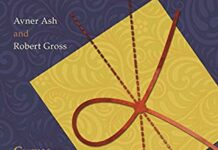
Ebook Info
- Published: 2012
- Number of pages: 280 pages
- Format: PDF
- File Size: 2.94 MB
- Authors: Avner Ash
Description
A look at one of the most exciting unsolved problems in mathematics todayElliptic Tales describes the latest developments in number theory by looking at one of the most exciting unsolved problems in contemporary mathematics―the Birch and Swinnerton-Dyer Conjecture. In this book, Avner Ash and Robert Gross guide readers through the mathematics they need to understand this captivating problem.The key to the conjecture lies in elliptic curves, which may appear simple, but arise from some very deep―and often very mystifying―mathematical ideas. Using only basic algebra and calculus while presenting numerous eye-opening examples, Ash and Gross make these ideas accessible to general readers, and, in the process, venture to the very frontiers of modern mathematics.
User’s Reviews
Editorial Reviews: Review “The authors present their discussion in an informal, sometimes playful manner and with detail that will appeal to an audience with a basic understanding of calculus. This book will captivate math enthusiasts as well as readers curious about an intriguing and still unanswered question.”—Margaret Dominy, Library Journal”Minimal prerequisites and its clear writing make this book (which even has a few exercises) a great choice for a seminar for mathematics majors, who at some point should have such an excursion to one of the frontiers of mathematics.” ― Mathematics Magazine”The authors of Elliptic Tales do a superb job in demonstrating the approach that mathematicians take when they confront unsolved problems involving elliptic curves.”—Sungkon Chang, Times Higher Education”One cannot help being impressed, in reading the book and pursuing a few of the references, by the magnitude of the enterprise it chronicles.”—James Case, SIAM News”Ash and Gross thoroughly explain the statement and significance of the linchpin Birch and Swinnerton-Dyer conjection. . . . [A]sh and Gross deliver ample and current intellectual and technical substance.” ― Choice”I would envision this book as an excellent text for an undergraduate ‘capstone’ course in mathematics; the book lends itself to independent reading, but topics may be explored in much greater depth and rigor in the classroom. Additionally, the book indeed brings together ideas from calculus, complex variables and algebra, showing how a single mathematical research question may require an integrated understanding of the various branches of mathematics. Thus, it encourages students to reinforce their understanding of these various fields, while simultaneously introducing them to an open question in mathematics and a vibrant field of study.”—Lisa A. Berger, Mathematical Reviews Clippings”The book is very pleasantly written, and in my opinion, the authors have done an admirable job in giving an idea to non-experts what the Birch-Swinnerton Dyer conjecture is about.”—Jan-Hendrik Evertse, Zentralblatt MATH”The book’s most important contributions . . . are the sense of discovery, invention, and insight into the habits of mind used by mathematicians on this journey. I would recommend this book to anyone who wants to be challenged mathematically or who wants to experience mathematics as creative and exciting.”—Jacqueline Coomes, Mathematics Teacher”[T]his book is a wonderful introduction to what is arguably one of the most important mathematical problems of our time and for that reason alone it deserves to be widely read. Another reason to recommend this book is the opportunity to share in the readily apparent joy the authors have for their subject and the beauty they see in it, not least because . . . joy and beauty are the most important reasons for doing mathematics, irrespective of its dollar value.”—Rob Ashmore, Mathematics Today”This book has many nice aspects. Ash and Gross give a truly stimulating introduction to elliptic curves and the BSD conjecture for undergraduate students. The main achievement is to make a relative easy exposition of these so technical topics.”—Jonathan Sanchez-Hernandez, Mathematical Society”A carefully thought out presentation.”—Danny Yee, Danny Reviews Review “Assuming only what every mathematically inclined freshman should know, this book leads the reader to an understanding of one of the most important conjectures in current number theory―whose proof is one of the Clay Mathematics Institute’s million-dollar prize problems. The book is carefully and clearly written, and can be recommended without hesitation.”―Peter Swinnerton-Dyer, University of Cambridge”The Birch and Swinnerton-Dyer Conjecture is one of the great insights in number theory from the twentieth century, and Ash and Gross write with care and a clear love of the subject. Elliptic Tales will have wide appeal.”―Peter Sarnak, Princeton University From the Inside Flap “Assuming only what every mathematically inclined freshman should know, this book leads the reader to an understanding of one of the most important conjectures in current number theory–whose proof is one of the Clay Mathematics Institute’s million-dollar prize problems. The book is carefully and clearly written, and can be recommended without hesitation.”–Peter Swinnerton-Dyer, University of Cambridge”The Birch and Swinnerton-Dyer Conjecture is one of the great insights in number theory from the twentieth century, and Ash and Gross write with care and a clear love of the subject.Elliptic Tales will have wide appeal.”–Peter Sarnak, Princeton University From the Back Cover “Assuming only what every mathematically inclined freshman should know, this book leads the reader to an understanding of one of the most important conjectures in current number theory–whose proof is one of the Clay Mathematics Institute’s million-dollar prize problems. The book is carefully and clearly written, and can be recommended without hesitation.”–Peter Swinnerton-Dyer, University of Cambridge”The Birch and Swinnerton-Dyer Conjecture is one of the great insights in number theory from the twentieth century, and Ash and Gross write with care and a clear love of the subject. Elliptic Tales will have wide appeal.”–Peter Sarnak, Princeton University About the Author Avner Ash is professor of mathematics at Boston College. Robert Gross is associate professor of mathematics at Boston College. They are the coauthors of Fearless Symmetry: Exposing the Hidden Patterns of Numbers (Princeton). Read more
Reviews from Amazon users which were colected at the time this book was published on the website:
⭐There is often a large gap between elementary texts or monographs and advanced treatises on a particular mathematical topic. This gap is due to the lack of motivation or “intuitive” guidance of the relevant concepts, and this is absolutely essential for real understanding of mathematics. Given their emphasis on rigor in presentation and argument, professional mathematicians are frequently antithetic to “handwaving” or pictures to convey mathematical ideas. But such methods enhance the understanding of mathematical concepts, and one might argue (with strong justification) would be impossible without it. So even a statement to the effect that the Birch and Swinnerton-Dyer conjecture is an assertion that “the analytic and algebraic ranks of elliptic curves are equal” can be of enormous help to those who desire a solid in-depth understanding of this conjecture and elliptic curves in general. Early on in this book, the authors make such a statement, along with many others that enable readers to gain insight about elliptic curves that otherwise could only be obtained by painstaking research into some of the early papers on this subject (or be part of the oral tradition of the lineage of fine mathematicians doing research on elliptic curves). Studying this book will therefore be invaluable to those who are just beginning to study elliptic curves, and have a real thirst for understanding their properties and applications. The applications of elliptic curves are immense, reaching into areas such as cryptography, dynamical systems, quantum field theory, and superstring theory for starters. But elliptic curves are fascinating in and of themselves, and their beauty alone justifies their study and their placement in pure mathematics. Some of the mathematical problems that elliptic curves are used to resolve go way back, such as the congruent number problem, which has its origin in the mathematical musings of the ancient Greeks, and concerns the finding of right triangles with rational sides that have integral area. On the physics side, elliptic curves are used to solve the spinning top problem, the motion of the plane pendulum, and interestingly the dynamical behavior of the perihelion of Mercury. They are ubiquitous in exactly-solved models in statistical mechanics, and are used effectively in public key cryptography. The authors don’t mention all of these applications, but because of its emphasis on both the analytic and algebraic concepts behind elliptic curves, readers of this book will be amply prepared to understand them if they so desire. With more background in algebra and complex analysis (but not a whole lot really), they will also be able to move on to more advanced treatments of elliptic curves such as the parity and Shafarevich-Tate conjectures and Neron models. With considerably more preparation readers can tackle higher order generalizations of elliptic curves such as hyperelliptic curves and Abelian varieties, and eventually gain entrance into the somewhat mysterious subject of elliptic cohomology.
⭐If anyone evers asks you (assuming you have a degree in math), “what do mathematicians actually do?” this is a good book to hand to them. It covers the basics of elliptic curves using as little machinery as possible. I agree with other reviewers that reading this book requires a certain level of mathematical maturity beyond what a typical student gets out of a basic calculus course, but anyone with enough gumption can work through the material.The authors are careful to develop concepts as needed, but no more than that. For example, groups and finite fields get a nice elementary treatment. I found reading this book to be a real joy.I also recommend it to anyone with a degree in math who is curious about why elliptic curves are so important in the field of algebraic geometry.I deducted one star for overselling who can comfortably read this book, but I still highly recommend it for readers who want to know something about elliptic curves–they are, after all, how Fermat’s Last Theorem fell! To be clear, you won’t be anywhere near understading the proof Wiles developed for FLT, but the concept of rational points on elliptic curves is where it all begins.
⭐This is one of very few non-textbooks I have read on Mathematics. This short book is written in everyday language requiring little more that an understanding of the concept of function, y = f(x), z = F(x,y), or even F(x,y,z) = 0. A short review of these topics and the basic algebra of lines in a plane, y = mx + b, is all the interested reader needs to delve quite deeply into one of the most intriguing areas of modern mathematics. For the amateur mathematician, perhaps a college math major or minor who has been away from formal mathematics since graduation, will find this an easy read, a quite informal treatise of this branch of Modern Mathematics. Specifically, the book prepares the reader for his first introduction to the “Birch and Swinnerton-Dyer (no relation) Conjecture which proposes that under certain conditions the algebraic and geometric degrees of a curve C, are equal.
⭐I assigned this to some math olympiad students. It was a bit harder for them than I expected. In some sense the real audience for the book is adventurous high school students. I wish I had read this book when I was in high school. With a little bit of help regarding projective geometry and analytic continuation from a senior person, any motivated high school student learn a tremendous amount from the this book.For string theory people, its a good way to start learning about modular forms and elliptic curves. Another thing about this book is that it is VERY CHEAP. In that sense the book is a can’t fail book. You won’t be wasting money on this because it is so cheap and you won’t be wasting time because it presents complicated things in very clear ways.
⭐I am not great at analysis, but I love the adventure of math. I love the questions mathematicians ask and appreciate the simplicity of a child’s curiosity hidden behind the ornate technical jargon. For years, I’ve tried to understand the concepts behind elliptic curves, not just the groups that can be formed, but the actual mathematical coordination required to relate the ideas. I haven’t been completely successful, yet.I read the first 4 chapters of this book, and can tell the authors have tried to accommodate me. They pay special attention to including ALL of the information needed to follow the arguments right there in the text.This certainly isn’t a typical math book. It is not meant for accomplished, practicing mathematicians; it’s a book for intelligent people who want inside that elite club and need all the information explained without too much jargon. I LIKE!!
⭐This book explains the Birch–Swinnerton-Dyer Conjecture in the mathematical field of elliptic curves. We get 14 chapters of background before the conjecture is stated in chapter 15; by that point we have learned a wide range of interesting mathematics, and are in a position, if not to fully understand, at least to appreciate the Conjecture and its importance.The route to this point covers a lot of ground. Each new piece of mathematics introduced is (relatively!) straightforward, but by the end, there is just so much machinery in play, that it all becomes a little overwhelming. That feeling is good for understanding just how deep this Conjecture is.I was reminded of things I learned long ago, and learned lots of new interesting pieces of mathematics: an algebraic definition of the projective plane, how points on a curve can have a group structure, group generators, analytic continuation, series expansions, and much much more. What is great about this book is the way each new piece is slotted into the picture with a route map of where each chapter is going, explanations of how the pieces fit, and explanations of the importance and meaning of the concepts.There are exercises along the way, of a form that deepens understanding, there for the serious reader. I was more of a visitor, looking at the interesting details, frankly skimming a few of them, but not putting in the work needed to live there. But I had a good time as a tourist.
⭐This treatise is a brave attempt at explaining in the simplest of terms possible one of the greatest of mathematical challenges for this millenium, the Birch and Swinnerton – Dyer conjecture. Firstly I would say that unless you have studied pure maths at undergraduate level then you will be quickly driven into despair. You really need to have studied the rudiments of abstract algebra, number tbeory, and some analysis although not at any great depth. Ash and Gross cover a wide range of sub topics in math and skilfully pull them together to explain what the BSD is about. If you are prepared to do a bit of work and read around the topics presented then it should not be at all a struggle. Reading this is a quick dash into the world of mathematics at a professional level and thus provides an excellent insight into how professional mathematicians think. The text is reader friendly rather than line after line of rigour. On completion you will understand how broad the extent of mathematical understanding is required but have enjoyed and gained from the experience. The authors have done a great job and the book is enthusing.
⭐An superbly accessible accouting of ellyptic curves and related concepts and theories. It sometimes seems that mathematicians hide their ideas behind mysterious words almost as Guild members would hide their skills. This approach of stripping the mathematics bare of the structure around which it is built (Bourbaki?) seems to me at the heart of the lack of interest in our education system and in our public at large. It seems to make mathematics special, mystical, and not for ordinary folk. These authors in their non-academic writings make a valiant attept to pull down the screens and show us what is behind – and they do it brilliantly. I lost count of the ideas this book clarified for me.
⭐This book is an excellent attempt to explain the modern ideas around elliptic curves. It occupies what might be uncomfortable ground between a popular account and a textbook but succeeds admirably. If you have the requisite background, about a year of college maths, you will not be disappointed. Why only 4 stars, the typesetting is poor, with equations broken up, you will need to write them out on a single line to follow them.
⭐It promises an easy walk in the manner of the Canterbury tales. Actually I wode eqoth that Chaucer is a much easier read! The early part is easy going, but the terrain rapidly becomes waterlogged; and you have to pick up and carry bits of heavy apparatus on the way without a clear understanding of why. As you drive the pitons into the last few chapters the ascent is complete, and in a blue haze below is the stupendous, shimmering Birch Swinnerton Dyer conjecture, into which you must dive. As Butch Cassidy said, the fall alone will probably kill us.To be less fatuous, I do now have some considerable inkling about elliptic curves, and why degree three is the interesting one. By the way, I have an MA in sums but I found the going fairly tough: one chapter a day was all I could take – but there are many actual example case studies to assist and they do explain everything clearly. It would help you to already know about groups, rings and fields.
Keywords
Free Download Elliptic Tales: Curves, Counting, and Number Theory in PDF format
Elliptic Tales: Curves, Counting, and Number Theory PDF Free Download
Download Elliptic Tales: Curves, Counting, and Number Theory 2012 PDF Free
Elliptic Tales: Curves, Counting, and Number Theory 2012 PDF Free Download
Download Elliptic Tales: Curves, Counting, and Number Theory PDF
Free Download Ebook Elliptic Tales: Curves, Counting, and Number Theory


